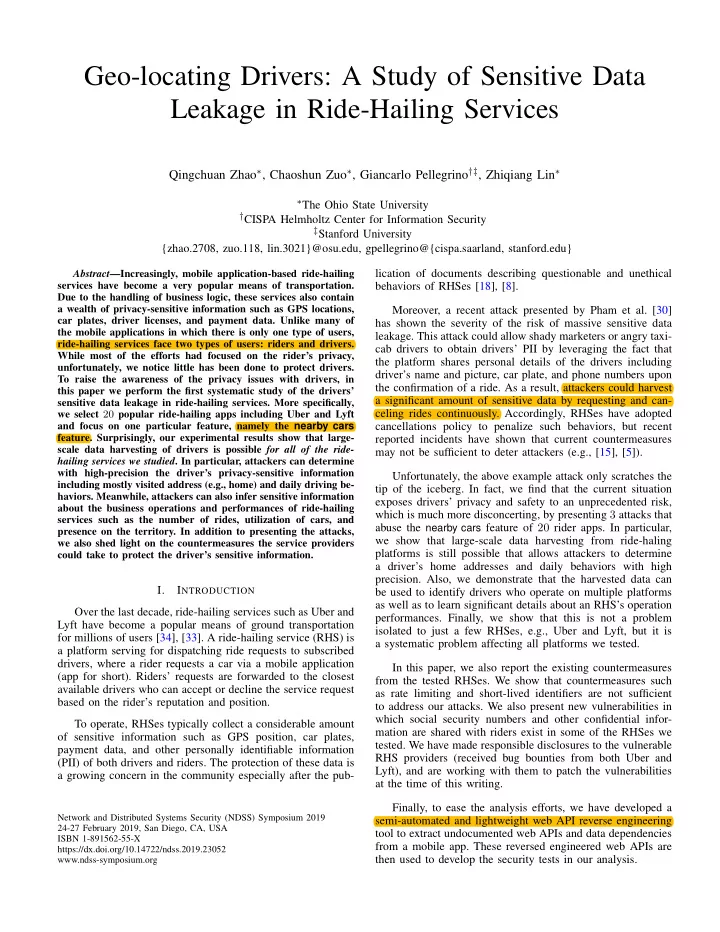

Geo-locating Drivers: A Study of Sensitive Data Leakage in Ride-Hailing Services Qingchuan Zhao ∗ , Chaoshun Zuo ∗ , Giancarlo Pellegrino †‡ , Zhiqiang Lin ∗ ∗ The Ohio State University † CISPA Helmholtz Center for Information Security ‡ Stanford University {zhao.2708, zuo.118, lin.3021}@osu.edu, gpellegrino@{cispa.saarland, stanford.edu} lication of documents describing questionable and unethical Abstract —Increasingly, mobile application-based ride-hailing services have become a very popular means of transportation. behaviors of RHSes [18], [8]. Due to the handling of business logic, these services also contain a wealth of privacy-sensitive information such as GPS locations, Moreover, a recent attack presented by Pham et al. [30] car plates, driver licenses, and payment data. Unlike many of has shown the severity of the risk of massive sensitive data the mobile applications in which there is only one type of users, leakage. This attack could allow shady marketers or angry taxi- ride-hailing services face two types of users: riders and drivers. cab drivers to obtain drivers’ PII by leveraging the fact that While most of the efforts had focused on the rider’s privacy, the platform shares personal details of the drivers including unfortunately, we notice little has been done to protect drivers. driver’s name and picture, car plate, and phone numbers upon To raise the awareness of the privacy issues with drivers, in the confirmation of a ride. As a result, attackers could harvest this paper we perform the first systematic study of the drivers’ a significant amount of sensitive data by requesting and can- sensitive data leakage in ride-hailing services. More specifically, celing rides continuously. Accordingly, RHSes have adopted we select 20 popular ride-hailing apps including Uber and Lyft and focus on one particular feature, namely the nearby cars cancellations policy to penalize such behaviors, but recent feature. Surprisingly, our experimental results show that large- reported incidents have shown that current countermeasures scale data harvesting of drivers is possible for all of the ride- may not be sufficient to deter attackers (e.g., [15], [5]). hailing services we studied . In particular, attackers can determine with high-precision the driver’s privacy-sensitive information Unfortunately, the above example attack only scratches the including mostly visited address (e.g., home) and daily driving be- tip of the iceberg. In fact, we find that the current situation haviors. Meanwhile, attackers can also infer sensitive information exposes drivers’ privacy and safety to an unprecedented risk, about the business operations and performances of ride-hailing which is much more disconcerting, by presenting 3 attacks that services such as the number of rides, utilization of cars, and abuse the nearby cars feature of 20 rider apps. In particular, presence on the territory. In addition to presenting the attacks, we show that large-scale data harvesting from ride-haling we also shed light on the countermeasures the service providers platforms is still possible that allows attackers to determine could take to protect the driver’s sensitive information. a driver’s home addresses and daily behaviors with high precision. Also, we demonstrate that the harvested data can I. I NTRODUCTION be used to identify drivers who operate on multiple platforms as well as to learn significant details about an RHS’s operation Over the last decade, ride-hailing services such as Uber and performances. Finally, we show that this is not a problem Lyft have become a popular means of ground transportation isolated to just a few RHSes, e.g., Uber and Lyft, but it is for millions of users [34], [33]. A ride-hailing service (RHS) is a systematic problem affecting all platforms we tested. a platform serving for dispatching ride requests to subscribed drivers, where a rider requests a car via a mobile application In this paper, we also report the existing countermeasures (app for short). Riders’ requests are forwarded to the closest from the tested RHSes. We show that countermeasures such available drivers who can accept or decline the service request as rate limiting and short-lived identifiers are not sufficient based on the rider’s reputation and position. to address our attacks. We also present new vulnerabilities in which social security numbers and other confidential infor- To operate, RHSes typically collect a considerable amount mation are shared with riders exist in some of the RHSes we of sensitive information such as GPS position, car plates, tested. We have made responsible disclosures to the vulnerable payment data, and other personally identifiable information RHS providers (received bug bounties from both Uber and (PII) of both drivers and riders. The protection of these data is Lyft), and are working with them to patch the vulnerabilities a growing concern in the community especially after the pub- at the time of this writing. Finally, to ease the analysis efforts, we have developed a Network and Distributed Systems Security (NDSS) Symposium 2019 semi-automated and lightweight web API reverse engineering 24-27 February 2019, San Diego, CA, USA tool to extract undocumented web APIs and data dependencies ISBN 1-891562-55-X from a mobile app. These reversed engineered web APIs are https://dx.doi.org/10.14722/ndss.2019.23052 then used to develop the security tests in our analysis. www.ndss-symposium.org
Recommend
More recommend